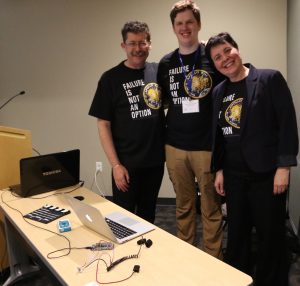Activity Metrics and Learning Analytics
If OLab was just a set of linked web pages, there would be little value in research and evaluation, even if the navigation of these links can be controlled. The true value of OLab lies in the sophisticated tracking and metrics of every user activity. This has been a feature of OpenLabyrinth from its outset and is far more than a simple web server page log or survey response system.
All clicks, question responses, object interactions and pathway choices are recorded internally, with precise millisecond timestamps. Map authors can also introduce internal variables (named Counters) which enable tracking of aggregate scores, conditional logic, pathway jumps and user feedback during map play.
In 2015, we incorporated the Experience API (xAPI)1 as an additional activity tracking mechanism into OpenLabyrinth. xAPI statements are simple in concept, taking a format similar to RDF triples, as Subject-Verb-Object. e.g.
Bob Did This.
These xAPI statements are sent to an external Learning Record Store (LRS) in a standard format, compliant with the Medbiquitous learning experience xAPI Profiles2. Indeed, the OpenLabyrinth group has been highly involved with the development of these standardized Profiles.
Using an LRS as an external, and standards compliant, repository has several advantages. Data can be simultaneously captured from multiple sources such as WordPress, Moodle, OpenLabyrinth, Desire2Learn, and can be analyzed using a wide variety of external learning analytics tools. LRSs are designed with big data principles in mind, can be easily federated, and are insulated from underlying architectural concerns. When using a standard xAPI Profile, the learning design author does not have to concern themselves with which LRS is used, or whether it uses a relational SQL architecture, or a non-SQL structure designed for very large data capacity.

We have successfully integrated our xAPI data capture and workflows across many such learning tools, including a cheap $30 Arduino-based bespoke sensor3, into single and multiple LRSs, such as SCORM Cloud, Learning Locker, Watershed, GrassBlade and Wax LRS. This has extended our capacity as an educational research platform enormously.
References
- Haag J. xAPI Overview – ADL Net. ADL Net. https://www.adlnet.gov/xAPI. Published 2015. Accessed May 29, 2017.
- Smothers V, Topps D, Meiselman E. Learning Experience | MedBiquitous Consortium. Medbiqitous. http://www.medbiq.org/learning_experience. Published 2016. Accessed February 1, 2016.
- Meiselman E, Topps D, Albersworth C. Medbiq xAPI workshop. In: Strothers V, Greene P, eds. Medbiq Annual Conference. Baltimore, MD; 2016. http://www.slideshare.net/topps/medbiq-xapi-workshop2b.
